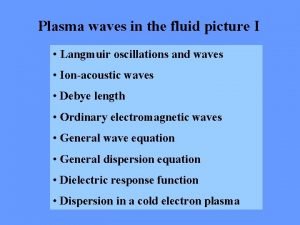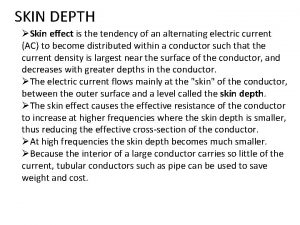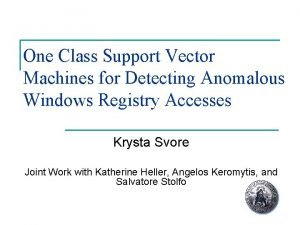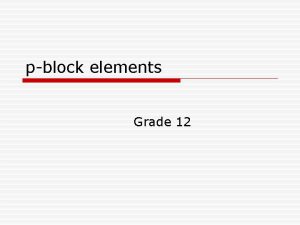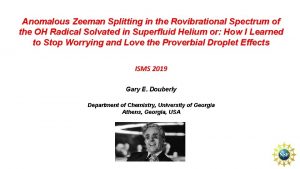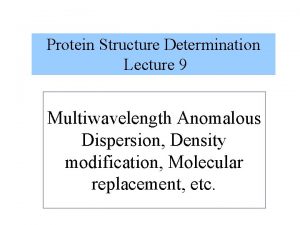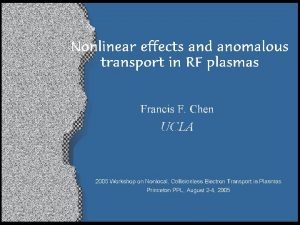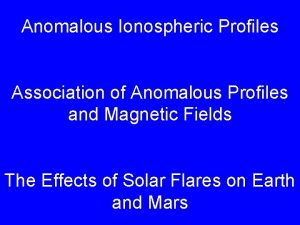ICPs show anomalous skin depth Plasma density is















- Slides: 15


ICPs show anomalous skin depth Plasma density is peaked on axis even when antenna is on periphery. UCLA

Helicon discharges are also peaked on axis Typical RF deposition profiles are peaked at edge due to the TG mode Typical center-peaked density profile UCLA

Consider a discharge of moderate length 1. 2. 3. Electrons are magnetized; ions are not. Neglect axial gradients. Assume Ti << Te UCLA

We now have a simple equilibrium problem Ion fluid equation of motion ionization convection CX collisions neglect B neglect Ti Ion equation of continuity where Result UCLA

Reduce to 1 D and normalize Result ion motion continuity All radial dependences are kept so far. UCLA

Electrons: short-circuit effect 1. Assume ionization is higher on the outside (tube 1) 2. Ions will diffuse inwards, to tube 2 3. Electrons can’t follow, but the sheath drop in 2 can increase to trap more electrons to neutralize the ions. 4. Electrons can effectively “move” across B by the sheath adjustment UCLA

The electrons can then follow Boltzmann • The short-circuit effect allows electrons to thermalize across B in nsecs. • Electrons then fall into their most probable distribution: Maxwellian • They then follow the Boltzmann relation everywhere. This is our basic assumption It has amazing consequences! UCLA

3 equations for 3 unknowns: v, n, ion motion continuity electron Boltzmann Eliminating n and , we have an ODE for v : UCLA

Matching to Debye sheath is automatic This “plasma solution” has dv/dr as v cs at the sheath edge. All radial variations can be taken into account in this equation. Introduce dimensionless variables This equation yields the profiles of v, n, and Vs in equilibrium UCLA

Properties of this “universal” equation • Plasma properties enter only in k (r ) in the nonlinear u 2 term. • The equilibrium profiles are the same if k is the same. • The profiles are unchanged if the quantities in are changed. • The B-field does not appear. B can be strong or zero. UCLA

Solutions for constant k Let nn and Te be uniform, so k is a constant. Self-similar profiles for 3 values of k Re-scale so a = r / a All profiles become identical! And n (r ) is always peaked on axis. UCLA

How to treat non-uniform nn, Te 1. Local ionization balance gives inverse relation between n n and Te. 2. Equation of continuity for neutrals yields neutral depletion profile. 3. A code EQM was developed to solve these equations for given Te(r). 4. Te(r) depends on the specific discharge. We did this for helicons. 5. The HELIC code gives Prf(r) for given n(r), nn(r), and Te(r). 6. Iteration of EQM with HELIC gives absolute-value profiles. One example: n(r) and Prf(r) Te(r) and neutral depletion UCLA

UCLA

Title here UCLA
 Total internal reflection in a semicircular glass block
Total internal reflection in a semicircular glass block Langmuir waves
Langmuir waves Sheath plasma
Sheath plasma Debye length
Debye length Skin depth effect
Skin depth effect Anomalous
Anomalous Anomalous properties of nitrogen
Anomalous properties of nitrogen Examples of linear expansion in daily life
Examples of linear expansion in daily life Anomalous mirage archer
Anomalous mirage archer Abrupt blunt with no formalities
Abrupt blunt with no formalities Negative pronoun
Negative pronoun Anomalous zeeman effect
Anomalous zeeman effect Anomalous state of knowledge
Anomalous state of knowledge Anomalous transport
Anomalous transport Protein structure determination
Protein structure determination Anomalous picture
Anomalous picture

